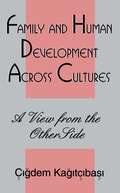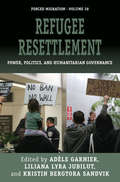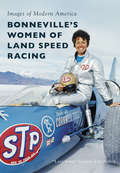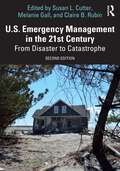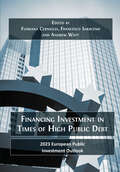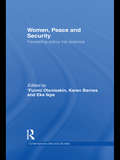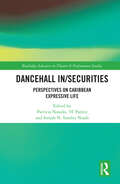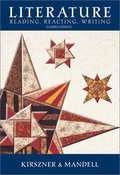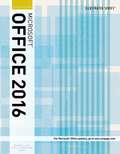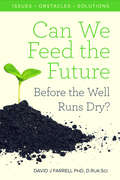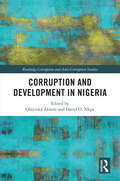- Table View
- List View
52ステップでやさしく解説 ビジネスマーケティング入門
by オーウェン・ジョーンズ「52ステップでやさしく解説 ビジネスマーケティング入門」は、「ビジネスのためにインターネットを利用することのポテンシャルには気づいているが、ビジネスを軌道に乗せるのにいっぱいいっぱいで、どうやってネット上で事業推進したらいいか分からない」という方、「その方法を調べるための時間がない」という方、「ネットビジネスを推進するために重要な情報だけを、今すぐ簡単に知りたい」という方…そんな皆様のために書かれました。 本書では、インターネットを利用した事業推進に関して当面の間必要と思われるあらゆる側面を52の短い章に分けて網羅しています。そのため、その他のビジネス本を買う心配は要りません。 インターネットは今でも急速に進化していますが、本書のように52のモジュールを使ったビジネス本はふたつとないことをお約束します。
メーガンの試験: メーガン、来たる試験に心配を募らせていく・・・ (メーガンシリーズ #4)
by オーウェン・ジョーンズメーガンの試験 メーガンは、自分には他の人にはない超能力があると気がつき始めた十三歳の少女。彼女は、そのことについて、最初に母に打ち明けてみたが、その結果ひどいお仕置きを受けたため、そのことについては自分の心の内に秘めておくことにした。 しかし、彼女には手を貸そうとする者たちと、特別な友情を示す動物がいた。ただし、彼らは、通常の次元の世界では『生きている』者たちではなかった。彼らは、死んだ者たちだった。 メーガンには、そのような友達が二人と一匹いた。地上での最後の前世がスー族であった彼女の魂の導き役であるワシンヒンシャ、母方の祖父のおじいちゃん、巨大なシベリアトラのグルル。 ワシンヒンシャは、精神や超能力や科学では説明できないこと全般に精通している。祖父は、新人の『死者』。グルルは、想像通り、トラの言葉しか話すことはできず、もちろんそのほとんどが、人には理解できない。 『メーガンの試験』の中で、メーガンは試験のことを極端なまでに心配する。なぜなら、それは、彼女が初めて受ける本格的な試験だからだ。彼女は、文字通り心配のし過ぎで体調を崩すが、魂の導き役ワシンヒンシャからのちょっとした激励で、彼女はそれを乗り越えていく。
書く技術: 電子書籍、PLRコンテンツ、ブログを (方法...シリーズ #123)
by オーウェン・ジョーンズ本書『電子書籍、PLRコンテンツ、ブログを書く方法』をご購入いただきありがとうございます。 この本の内容があなたにとって有益なものであることを願っています。 さまざまな形態のコンテンツ執筆に関する本書の情報は、それぞれ千字ほどからなる十八の章にまとめてあります。 執筆能力を高めたい方々にとって、興味深い内容となっているはずです。 本書を購入して頂いたボーナスプレゼントとして、ご購入者様が本書の内容をご自身のウェブサイトやブログ、メールマガジンで自由に使用できる許諾を付与させて頂きます。もちろん、本書の内容をまずご自身の言葉で書き直すことができるのであれば、その方が良いでしょう。 本書の内容を分割して、記事を再販して頂いても構いません。実際のところ、ご購入者様に付与されていない唯一の権利は、本書を購入した内容のまま、再販したり誰かに譲渡したりすることだけです。 ご意見・ご感想がありましたら、本書の購入元へお伝えください。 最後にもう一度、本書をご購入いただいたことに感謝申し上げます。
マルタ語の動詞(100個の活用させた動詞): 100個の動詞の活用させ方 (Trilogía Arcángel Ser. #Vol. 1)
by エディトーリアルカリブダス電子書籍のために特別に書かれた「マルタ語の動詞」は完全に100個の活用させた必要な動詞とともに意味に加えて、マルタ語で全ての動詞の時制を構成する入門もあります。本書は読めなくて消えたテキストかイメージがないので、全てのテキストで検索できます。
グランパのいる天国: Isländernes Lovbog I Fristatens Tid. Text I, Volume 1...
by アンバー・リチャーズ「グランパのいる天国」は、身近な人を失った幼い子供に向けて、キリスト教の視点から書かれています。大切な人を失って悲しんでいる子供に、何と声を掛けますか? 子供は抽象的には考えません。 死は、一般的な言葉で説明するには難しいテーマです。悲しみの中においては特に難しいものです。それでも、子供は答えを求めます。 お子さんが死や悲しみを乗り越える手助けをするために、この電子書籍を使ってください。美しい写真を使ったこの本は、悲しみを受け入れるとともに、希望と安らぎを与えるでしょう。 「はじめに」では、この本をお子さんに読まれる大人の皆さまに、いくつか提案しています。悲しみの中にいるお子さんを支えるため、お子さんの状況に合わせて本の内容を変えてみてください。たとえば、おじいさん以外の大切な人に置き換えてみてください。「グランパのいる天国」をぜひダウンロードしてください。
子育てスタイルのガイド: 子育てガイド
by アマンダ·ウィンター何十年にもわたってテストされた戦略により、この電子ブックはあなたができる最高の親になるための最速かつ最も効果的な方法を示します。 わずか1週間で最も成功した親になる方法を学べられます。 穏やかでやりがいのある簡単なテクニックで、これまでにないような子供との絆と信頼を築きましょう。
Family and Human Development Across Cultures: A View From the Other Side
by €igdem KagitibasiThe culmination of 15 years of research by a Turkish psychologist who was educated in the West, this volume examines both the theoretical and practical aspects of cross-cultural psychology. It takes a contextual-developmental-functional approach linking the child, family, and society as they are embedded in culture. A refreshingly different view, the author presents a portrait of human development from "the other side"--from the perspective of the "majority world." In a world seemingly dominated by American psychology, she proposes the cross-cultural orientation as a corrective to the culture-boundedness of much of Euro-American psychology. Analyzing human development in context while avoiding the pitfalls of extreme relativism, this work studies development with an inclusive, holistic, and ecological perspective, focusing on the development of the self and of competence. In so doing, it also attempts to combine cultural contextualism with universalistic standards and psychological processes. It proposes a theory of family change which challenges some commonly held modernization assumptions, and links theory and application while examining the role of psychology in inducing social change.
Refugees Welcome?: Difference and Diversity in a Changing Germany
by Sharon Macdonald Jan-Jonathan BockThe arrival in 2015 and 2016 of over one million asylum seekers and refugees in Germany had major social consequences and gave rise to extensive debates about the nature of cultural diversity and collective life. This volume examines the responses and implications of what was widely seen as the most significant and contested social change since German reunification in 1990. It combines in-depth studies based on anthropological fieldwork with analyses of the longer trajectories of migration and social change. Its original conclusions have significance not only for Germany but also for the understanding of diversity and difference more widely.
Refugee Resettlement: Power, Politics, and Humanitarian Governance (Forced Migration #38)
by Adèle Garnier Liliana Lyra Jubilut Kristin Bergtora SandvikExamining resettlement practices worldwide and drawing on contributions from anthropology, law, international relations, social work, political science, and numerous other disciplines, this ground-breaking volume highlights the conflicts between refugees’ needs and state practices, and assesses international, regional and national perspectives on resettlement, as well as the bureaucracies and ideologies involved. It offers a detailed understanding of resettlement, from the selection of refugees to their long-term integration in resettling states, and highlights the relevance of a lifespan approach to resettlement analysis.
Bonneville's Women of Land Speed Racing (Images of Modern America)
by “LandSpeed” Louise NoethAt Bonneville, record holders must first earn the right to present themselves on the starting line. This requires passing rigorous safety and technical checks for driver, rider, and speed machine. Gender is inconsequential. Through the years, more than 200 women have made the cut and donned fireproof clothing and helmets. Dozens have set land speed records--35 in excess of 200 miles per hour, six above 300 miles per hour, and one deaf female racer who roared past 500 miles per hour. Equally impressive are the women who helped propel the helmeted gals into glory. Few know how many women are skilled fabricators, mechanics, crew chiefs, and all-round land speed racing experts, all working out on a brutal, merciless, and barren sodium-soaked playa. And for decades dedicated volunteers have not only put down that all-important starting line but erected a speed village that inspired tens of thousands to visit, taunting the timing lights run after run. Since 1949, women have played an integral part. Without question, land speed racing has more women actively participating and setting records than any other segment of motorsports in the world.
U.S. Emergency Management in the 21st Century: From Disaster to Catastrophe
by Jon E. Keeley Susan L. Cutter Christopher T. Emrich Claire B. Rubin Monica Schoch-Spana Duane A. Gill Melanie Gall Sanam K. Aksha Susan Spierre Clark Alex Greer Arleen A. Hill Ayesha Islam Sarah L. Jackson “Gene” Longenecker, Herbert E. Liesel Ritchie Laura J. Stroup Alexandra D. Syphard William R. TravisOur understanding of hazards and disasters is rapidly changing, and it is unclear as to whether our existing management systems are adequate to adapt to current and future disasters. Thoroughly updated to include the latest research in the hazards and disasters field, U.S. Emergency Management in the 21st Century continues the tradition of giving readers access to exemplary case studies drawn from a wide variety of hazards and applied fields.NEW TO THE SECOND EDITION Discussion on COVID-19 pandemic and the lacking local capacity for preparedness. “Forgotten” hazards (heatwaves and coldwaves) in Phoenix, AZ and Buffalo, N.Y New challenges in hurricane preparedness and response with rapid intensification. Changing cycles of water volume in the west resulting in storage emergencies. Cascading hazards and out-of-sight water crises in the Southwest Extreme precipitation resulting in flash flooding in Tennessee, New York City, Montana, and Vermont. Updated conclusion describing divergence between federal, state, and local emergency management concerns and priorities. A new co-editor, Melanie Gall, recognized for her teaching and scholarship on natural hazards and emergency management. U.S. Emergency Management in the 21st Century remains an indispensable textbook on disaster case studies, emergency management policy and practice. An essential resource for students, public, and professionals alike.
Financing Investment in Times of High Public Debt
by Andrew Watt Francesco Saraceno “Floriana CernigliaThe fourth book in the ‘European Public Investment Outlook’ series focuses on the urgent issue of how to finance needed investment in critical tangible and intangible infrastructure given high levels of public debt, a thorny problem facing many governments across Europe. Drawing on expertise from academics, researchers at public policy institutes and international governance bodies, the contributors analyse the current situation and prospects and propose feasible solutions. Financing Investment in Times of High Public Debt offers a powerful combination of high-level analysis of cross-continental policies and trends, with close examination of specific contexts in France, Italy, Germany and Spain. The chapters in Part II explore challenges including how to finance climate investments, the extent to which national promotional banks can offer solutions, EU budget reform and recent trends in tax progressivity. This book is essential reading for economists, policymakers, and anyone interested in implementing and financing public policy in Europe and wanting to better understand the intricacies of EU governance and institutions.
Women, Peace and Security: Translating Policy into Practice (Contemporary Security Studies)
by ’Funmi Olonisakin Karen Barnes Eka IkpeThis book provides a critical assessment of the impact of UN Resolution 1325 by examining the effect of peacebuilding missions on increasing gender equality within conflict-affected countries. UN Resolution 1325 was adopted in October 2000, and was the first time that the security concerns of women in situations of armed conflict and their role in peacebuilding was placed on the agenda of the UN Security Council. It was an important step forward in terms of bringing women’s rights and gender equality to bear in the UN’s peace and security agenda. More than a decade after the adoption of this Resolution, its practical reality is yet to be substantially felt on the ground in the very societies and regions where women remain disproportionately affected by armed conflict and grossly under-represented in peace processes. This realization, in part, led to the adoption in 2008 and 2009 of three other Security Council Resolutions, on sexual violence in conflict, violence against women, and for the development of indicators to measure progress in addressing women, peace and security issues. The book draws together the findings from eight countries and four regional contexts to provide guidance on how the impact of Resolution 1325 can be measured, and how peacekeeping operations could improve their capacity to effectively engender security. This book will be of much interest to students of peacebuilding, gender studies, the United Nations, international security and IR in general.
The Politics of Crisis Management
by Paul Arjen Boin Eric Stern Bengt Sundelius ‘t HartCrisis management has become a defining feature of contemporary governance. In times of crisis, communities and members of organizations expect their leaders to minimize the impact, while critics and bureaucratic competitors make use of social media to blame incumbent rulers and their policies. In this extreme environment, policymakers must somehow establish a sense of normality, and foster collective learning from the crisis experience. In the new edition of this uniquely comprehensive analysis, the authors examine how strategic leaders deal with the challenges they face, the political risks and opportunities they encounter, the pitfalls they must avoid, and the paths towards reform they may pursue. The book is grounded in decades of collaborative, cross-national and multidisciplinary case study research and has been updated to include new insights and examples from the last decade. This is an original and important contribution from experts in public policy and international security.
Dancehall In/Securities: Perspectives on Caribbean Expressive Life (Routledge Advances in Theatre & Performance Studies)
by Patricia Noxolo ‘h’ Patten Sonjah N. Stanley NiaahThis book focuses on how in/security works in and through Jamaican dancehall, and on the insights that Jamaican dancehall offers for the global study of in/security. This collection draws together a multi-disciplinary range of key scholars in in/security and dancehall. Scholars from the University of the West Indies' Institute of Caribbean Studies and Reggae Studies Unit, as well as independent dancehall and dance practitioners from Kingston, and writers from the UK, US and continental Europe offer their differently situated perspectives on dancehall, its histories, spatial patterning, professional status and aesthetics. The study brings together critical security studies with dancehall studies and will be of great interest to students, scholars and practitioners in theatre, dance and performance studies, sociology, cultural geography, anthropology, postcolonial studies, diaspora studies, musicology and gender studies.
African Perspectives on the Teaching and Learning of English in Higher Education (Global South Perspectives on TESOL)
by Alexandra Esimaje Bertus Van Rooy ‘Demola Jolayemi Daniel Nkemleke Ernest KluThis book brings together the work of African scholars and educators directly involved in initiatives to improve the teaching and learning of English in higher education across Africa. Offering alternative perspectives across different African countries with examples of decolonised practice in research, the book provides a critical discussion and examples of successful practice in the teaching of English in Africa. Each chapter of the book reports on a specific context and a specific teaching and/or learning initiative in higher education, with emphasis on comparability of information and on clear evaluation and critical analysis of the intervention. The editors offer a thoughtful comparison of different methods, strategies and results to provide an authoritative reference to effective strategies for English teaching and learning. The book paints a cohesive picture of the field of English language teaching in Africa and will be of great interest to researchers, scholars and postgraduate students in the areas of applied linguistics, English teaching and comparative education.
Literature: Reading, Reacting, Writing (Fourth Edition)
by Laurie G. Kirszner Stephen R. MandellA resource material for teaching students how to write about literature.
Illustrated Microsoft Office 365 and Office 2016 Introductory
by David W. Beskeen Carol M. Cram Jennifer Duffy Lisa Friedrichsen Elizabeth Eisner RedingWhether you're a computer rookie or hot shot, you can master Microsoft Office 2016 applications quickly with ILLUSTRATED MICROSOFT OFFICE 2016 & OFFICE 365 INTRODUCTORY, part of the popular Illustrated Series. Using a focused, user-friendly format, a two-page layout allows you to work through an entire task without turning the page. The book's easy to follow presentation highlights Learning Outcomes that outline the skills in each lesson. Larger full-color screen images reflect exactly what you should see on your own computer. Each module begins with a brief overview of the principles of the lesson and introduces a case study for further application. New Productivity Apps visually introduce Microsoft OneNote, Sway, Office Mix and Edge using fun, hands-on activities. Companion Sways provide videos and step-by-step instructions to help you master each app. In addition, MindTap and SAM help you further focus your study for results now and success later on the job.
Brunnstrom's Clinical Kinesiology (Sixth Edition)
by Peggy A. Houglum Dolores B. BertotiNow celebrating its 50 years in print, this text has held onto the foundation of its great success, while also being re-invented for today’s audience. The focus of this text remains the practical instruction of functional anatomy in order to quickly, and convincingly, guide readers to its use in professional performance. This text is filled with modern applications that will show your students the relevance of foundational material to their future careers.
Can We Feed The Future Before The Well Runs Dry?
by David Farrell PhD D.Rur.Sci.Mankind is at a crossroads. We need to increase food production by 70% by 2050 in the face of climate change, increased water and fertiliser demand, declining arable land area, environmental degradation and an affluent and rapidly-growing population with inequality rising quickly. But what about the one billion now living in poverty; many with insufficient money to buy food and go to bed hungry every night yet we waste sufficient food that would feed these and millions more. But are we as individuals prepared to put our shoulder to the wheel and give the poor the opportunity to improve their lot. Or will we continue on the well-worn pathway in an increasingly selfish consumer society rapidly using up our diminishing resources?
Spatial Tensions in Urban Design: Understanding Contemporary Urban Phenomena (The Urban Book Series)
by Ianira Vassallo Michele Cerruti But Giulia Setti Agim KercukuThis book provides an original research perspective to the field of contemporary urban conflicts. Even though violent conflicts have transformed cities during the XX century, it is nowadays possible to identify the phenomenon of “Tensions” as a specific contemporary both social and spatial urban changes catalyst.Through a collection of essays from various disciplines focusing on international case studies—from India to Europe to Latin America— the publication explores the multifaceted concept of “spatial tensions” as a lens for better understanding contemporary urban transformations. While tensions often depend on spatial dispositives and superstructures, they also offer a powerful key for design practices and strategies.
Corruption and Development in Nigeria (Routledge Corruption and Anti-Corruption Studies)
by Ọláyínká Àkànle and David O. NkpeDespite being Africa’s largest economy and most populous country, with abundant natural resources, Nigeria still faces substantial development challenges. This book argues that corruption lies at the heart of many of the country’s problems. Drawing on a range of different disciplinary perspectives, this volume explores the relationship between corruption and development, investigating the causes, contexts, and consequences of corruption, and the pathways for addressing it. As well as covering the wider background and theory surrounding corruption in the country, the book will investigate different sectors: the media, the judiciary, the health sector, industry, the criminal justice system, and of course politics and governance. The book concludes by considering attitudes and perceptions to corruption within Nigeria, current approaches to countering corruption, and future pathways to addressing the problem. This book’s critical investigation of the links between corruption and development in Nigeria will be of interest to researchers of corruption, development and African Studies, as well as to policy makers, practitioners, and local stakeholders.
Beyond All Directions
by Ṭhānissaro BhikkhuThe fifth collection of essays. Includes: Beyond All Directions, Lost in Quotation, An All-around Eye, Mettā Means Goodwill, On Denying Defilement, Virtue Without Attachment, The Limits of the Unlimited Attitudes, The Essence of the Dhamma, The Middles of the Middle Way, and The Arrows of Thinking.
KHA RI ḒIṰONGISE BUGU YA MUGUDI GIREIDI YA 10: UBC Contracted
by Mmbi M. N Maphiri N. R Ṋemukula M. A Dok. Maungedzo A.E Prof. Muloiwa T.WBugupfarwa iyi yo lundwa tshidele vhukuma. Yo ṅwalelwa u shumiswa nga vhagudi na vhagudisi uri vha nwe maḓi a tshisima tsha luambo tshi sa xiho. Vhaṅwali vho dzhiela nzhele Tshitatamennde tsha Pholisi ya Lushaka ya Kharikhuḽamu na u Linga; vha tou longondo kha gondo ḽeneḽo. Nazwino maitele haya maswa a u guda na u funza o vhekanywa nga nḓila i tevheleleaho u bva kha ino thero u ya kha iḽa, na u bva kha ino ngudo u ya kha i tevhelaho. Ri ṱuṱuwedza vhagudisi na vhagudi uri vha shumise bugupfarwa heyi yo faredzaho zwoṱhe zwo randelwaho kha uyu murole u itela uri vhagudi vha fhaṱee vha tshee vhaṋu. Ndi yone ya u thoma kha bennde ya FET, ngauralo i vhumba mutheo wo khwaṱhaho u itela u bveledza zwikili zwo faredzwaho kha CAPS, zwine zwa vha: u thetshelesa na u amba, u vhala, u ṅwala na u ṅekedza na kushumisele kwa luambo u buḓekanya na zwikili zwoṱhe. Mugudi u tea u shumisa bugu iyi yo pfumaho luambo a tshi dadamala kha vhuṱala he a ṋewa kha Bugu ya Mugudisi. Vhaṅwali vha fhulufhela uri luambo lwa Tshivenḓa lu ḓo vhulungea na u bveledzea tshidele u itela u lwa na tsiku ya u sa kona u ṅwala na u vhala kha vhaswa vha ano maḓuvha. Kha Ri Ḓiṱongise ndi yavho, bonyongo kha ḽi ṱangane!
KHA RI ḒIṰONGISE BUGU YA MUGUDI GIREIDI YA 10: UBC Uncontracted
by Mmbi M. N Maphiri N. R Ṋemukula M. A Dok. Maungedzo A.E Prof. Muloiwa T.WBugupfarwa iyi yo lundwa tshidele vhukuma. Yo ṅwalelwa u shumiswa nga vhagudi na vhagudisi uri vha nwe maḓi a tshisima tsha luambo tshi sa xiho. Vhaṅwali vho dzhiela nzhele Tshitatamennde tsha Pholisi ya Lushaka ya Kharikhuḽamu na u Linga; vha tou longondo kha gondo ḽeneḽo. Nazwino maitele haya maswa a u guda na u funza o vhekanywa nga nḓila i tevheleleaho u bva kha ino thero u ya kha iḽa, na u bva kha ino ngudo u ya kha i tevhelaho. Ri ṱuṱuwedza vhagudisi na vhagudi uri vha shumise bugupfarwa heyi yo faredzaho zwoṱhe zwo randelwaho kha uyu murole u itela uri vhagudi vha fhaṱee vha tshee vhaṋu. Ndi yone ya u thoma kha bennde ya FET, ngauralo i vhumba mutheo wo khwaṱhaho u itela u bveledza zwikili zwo faredzwaho kha CAPS, zwine zwa vha: u thetshelesa na u amba, u vhala, u ṅwala na u ṅekedza na kushumisele kwa luambo u buḓekanya na zwikili zwoṱhe. Mugudi u tea u shumisa bugu iyi yo pfumaho luambo a tshi dadamala kha vhuṱala he a ṋewa kha Bugu ya Mugudisi. Vhaṅwali vha fhulufhela uri luambo lwa Tshivenḓa lu ḓo vhulungea na u bveledzea tshidele u itela u lwa na tsiku ya u sa kona u ṅwala na u vhala kha vhaswa vha ano maḓuvha. Kha Ri Ḓiṱongise ndi yavho, bonyongo kha ḽi ṱangane!






